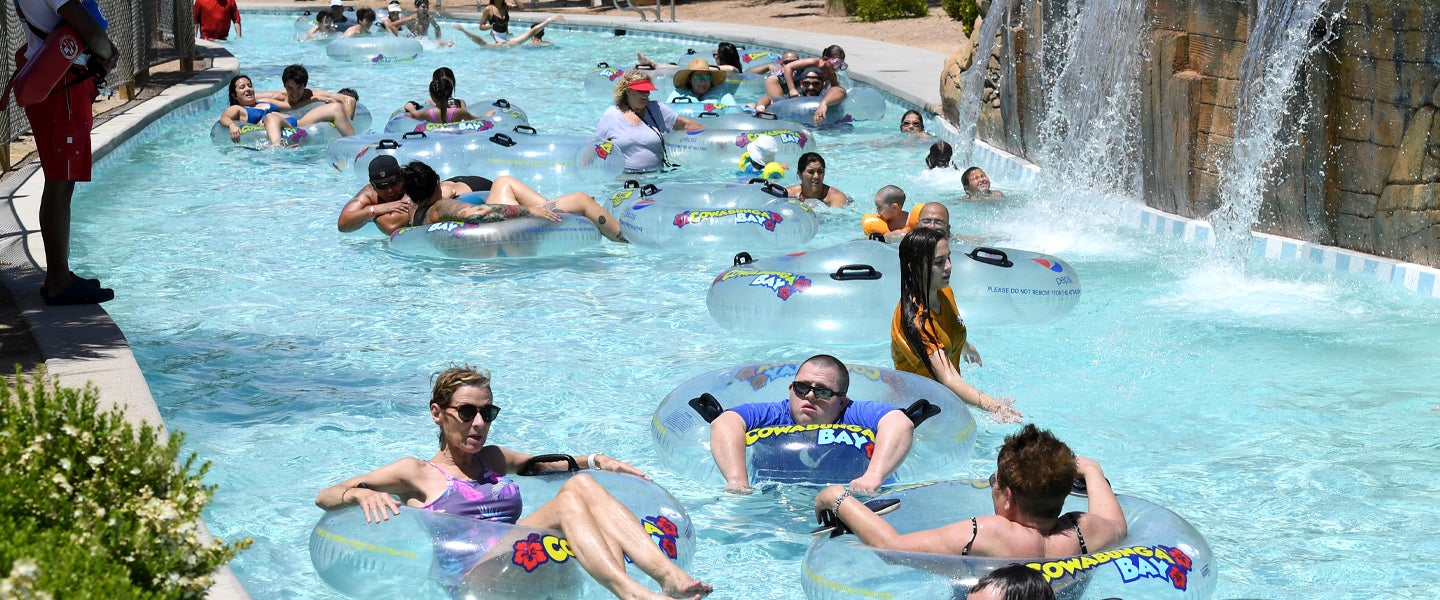The year was 1941. It was Fourth of July weekend, and an enterprising Wisconsin man named David Breault had engaged in a clever marketing tactic for his local, allegedly poppin’ nightclub: Supply visitors of the nearby Apple River with free inner tubes, so they could float along, lazily, with the current, while drinking loads of beer. Once they reached a stopping point, Breault, in a truck advertising his nightclub, would pick them up and deliver them right back to the starting point, where they were free to go again. And again. And again.
While there are several accounts that credit others as early tubing influencers — a 1965 edition of Sports Illustrated reveals how Princess Chumbhot of Nagar Svarga popularized the sport in Thailand, and eventually the world — it could be argued that Breault, an American tubing pioneer, set the stage for what would later come to be known as the lazy river, a cornerstone of summertime fun and relaxation.
It would take several decades from that fateful day of tubing and slamming ales before lazy rivers — and water parks in general, for that matter — would manifest as we know them today. As Aleatha Ezra of the World Waterpark Association explains, the phrase “lazy river” was first trademarked in the 1970s by an American businessman and theme park developer named George Millay (who founded SeaWorld), frequently credited as the grandfather of the water park industry worldwide.
John Seeker, who helped Millay manage numerous water parks over a period of about 25 years, tells me that “there was really no such thing as a water park” until Millay and his team founded the now-defunct Wet ‘n Wild Orlando in 1977. Prior to that, Seeker notes that there were several unaccompanied wave pools and gunite water slides scattered across the U.S., which is where Millay received some of his inspiration (in addition to the frequent traveling that he engaged in). “The wave-generating equipment was really designed to test the surface effects on ships,” Seeker explains, speaking of the earliest wave pools. “As folklore has it, someone fell in while they were testing a ship and thought it was a lot of fun — and so, wave pools for recreational use started.”
By the early 1980s, Seeker says, “George had a lot of slides down there that were pretty thrilling, but he was looking for something else that would be a little calmer — a little more family-oriented — and he came up with the idea of a lazy river.”
They quickly installed basic, slow-moving rivers at two Wet ‘n Wild locations — Orlando and Arlington, Texas (which has since been bought by Six Flags and rebranded as Hurricane Harbor) — and they were immediate hits. “The problem sometimes was that it would be too packed,” Seeker says.
While water slides, even back then, were sometimes daunting — especially to crowds that had only just been introduced to water parks as a whole — lazy rivers acted as a welcoming gateway that the whole family could enjoy. “There’s no fear,” Seeker explains. “It cools you off. You’re floating along, and it’s just a leisurely, happy time.” For anyone initially afraid of water slides, the rivers would literally float visitors around the entirety of the park, slowly and calmly introducing them to other, perhaps more thrilling attractions.
From a water park management perspective, lazy rivers are also able to hold a massive number of visitors, which can help prevent long lines for other attractions and keep customers constantly engaged, both of which are huge boons for business. “It really helps take a lot of capacity,” confirms Nick Neuman, water park enthusiast and CEO of Water Technology, Inc., which has designed and engineered countless lazy rivers.
But in recent years, Neuman explains that lazy rivers have become increasingly less, well, lazy. “We rarely do just a straight lazy river for anyone anymore,” he says. Instead, Neuman and his team have been meeting a demand for more thrilling attractions by engineering faster, deeper rivers that have waterfalls and waves and that interact with the nearby landscape. While many early lazy rivers travelled at a speed of 1.5 feet per second — about walking speed — Neuman says many modern variations travel at a speed of four or five feet per second, “which is flying.”
Some of these rivers even require that you ditch the inner tube entirely, instead donning only a life jacket for a more engaging, submerged aquatic experience. “It manifests as a really dynamic attraction,” Neuman says, excitedly.
While Neuman has trouble saying for certain why lazy rivers have become increasingly rapid and raging, he says there’s been an industry-wide push to make water park attractions like these more shareable on social media, by adding things like photo opportunities and interactive areas with waterfalls and geysers. He also adds that, more generally, there really is a demand from water park visitors for more thrilling rides. “Kids, we always say, they play up,” he explains. “If you had a five-year-old [back then], maybe a lazy river 10 years ago or 15 years ago was suitable. That same five-year-old now is going to have a higher acuity. They want more action, for sure.”
None of this is to say that lazy rivers have lost their place as the least thrilling, most relaxing attraction at water parks — water slides, too, have increased in size, speed and intensity, and lazy rivers simply required a slight, but still relatively lazy boost to keep up.
Nevertheless, if we keep trending toward more and more thrills, I can only imagine what our “lazy” rivers may look like several decades from now.

